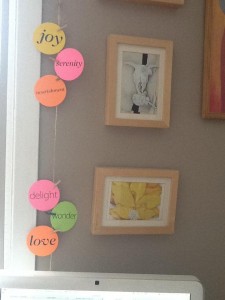During a coaching session a client mentioned how much she loved teaching. She looked forward to being in the classroom. Colour was really important to her. She brought a tool box full of coloured markers and other supplies that she used to teach in an interactive way that involved lots of visual work and colour.
We had been working on issues around getting other work done, prioritizing, and so on. I asked her if she brought the toolbox of markers out to do her preparation or to work on her research.
She didn’t. She did her preparation, and her writing and other tasks, in a standard office. Sitting at a desk. Using a computer. Hmmmm.

What is your office like?
The environment in which you work contributes to your ability to work effectively. And yet most of us don’t really think about tailoring that environment to our needs.
If you do any of your work at home, your home office is a space that you have considerable control over. It doesn’t also serve as the face of the organization to students and other visitors. There is no need to fit in with the offices around it. In fact, it makes sense for it to fit in with the home around it, a home that probably also reflects your personality.
However, even at work you have some control over your working environment.
- If you find it easier to make initial notes on flipchart paper with colourful markers then get a flipchart and keep a box of markers on your desk.
- Hang art that inspires and nourishes you on the wall. Or put a sculpture on your desk.
- Bring in a small area rug that makes your space feel more “you”.
- Arrange the furniture in the way that feels most comfortable to you.
There is no One Right Way
Some people feel most comfortable, and do their best work, if they dress the part of professional. They make a clear distinction between themselves and their students through dress, mannerisms, and office decor. I had a colleague who arranged his office furniture so that the desk was between him and the door, and students sat across the desk from him when they came for meetings.
Others are more relaxed and find the fact that they “never have to wear a tie again” one of the great attractions of an academic career. They arrange their office so that there is no physical barrier between them and their students when they meet in their office. Their appearance and manner are more casual.
Some people work best in a very structured environment that is uncluttered and ordered. Others work best when there is lots of colour and need things to be visible to remind them of what is ongoing.
What would happen if you figured out what worked best for you and let go of the expectations?
Finding your way
I have used the Wish Kit from Jennifer Hofmann to organize my own office and my own work patterns. This is now available for free, along with her other books about organizing space.

In this workbook (which is delivered electronically but I recommend you print out and write on), you are taken through a series of questions that enable you to identify what works and what doesn’t in your space. Instead of focusing on the perfect space and spending a lot of time and money to get there, it focuses on the qualities you need and moving towards a more supportive space gradually within whatever constraints you face (time, money, institutional rules, etc.).
I have returned to the Wish Kit to reflect on my space and make changes. The beauty of a PDF is that you can print it out as many times as you like as your life and work change. You could use it as part of your transition from teaching intensive periods to more research intensive periods: adjusting your office to support the dominant activities of the next few months.
Related posts:
Edited May 31, 2016. Links updated August 17, 2017.








Leave a Reply